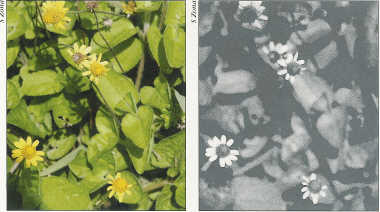Bees Eye View
Scott Zona, Ph.D., Former Palm Biologist

For some time, biologists have known that bees perceive light differently than humans do. What we see as visible light is a small portion of the electromagnetic spectrum and consists of a mixture of different colored light. Color is determined by the light's wavelength, which ranges from violet (400 nm wavelength) to red (700 nm). We are unable to see other portions of the spectrum, such as ultraviolet or infrared. Bees, on the other hand, see a portion of the spectrum shifted toward shorter wavelengths. Their eyes perceive yellows, greens, blues and purples as we do, but they also perceive ultraviolet (UV) light (180-400 nm). Bees do not perceive the red portion of the visible spectrum.
 | |
| What we see | What the bee sees |
Because their eyes are so different from ours, we can only approximate how bees see flowers. By using photographic equipment, we can visualize some components of bee vision that are normally invisible to us, namely the reflection or absorption of UV radiation. Plants contain chemicals that either reflect or absorb electromagnetic radiation, including UV, visible, and infrared (which we cannot see but we can feel as heat). Sunlight's UV radiation is absorbed, partially absorbed, or reflected by flowers and can be captured on black and white photographic film or with a digital camera, using special filters. In the resulting photograph, reflected UV appears white, and absorbed UV appears dark. Partially absorbed UV appears gray.
The two photos shown here are of a locally common weed, Achmella pilosa, in the sunflower family (Asteraceae). The photo on the left was taken in sunlight without any special filter, using a Minolta DiMAGE 7Hi digital camera. The right-hand photo was subsequently taken with a Wratten 18AUV filter attached to the camera. Typical of the sunflower family, Achmella has the common daisy-type “flower” (inflorescence) that is actually a group of two different kinds of flowers. The outer “petals” are individual flowers, called ray flowers. The central eye is a cluster of small flowers called disk flowers. Together, these two kinds of flowers make up the inflorescence we commonly call daisies or sunflowers. Achmella pilosa exhibits a common phenomenon seen in many Asteraceae: the bull's eye pattern formed by UV-reflecting ray flowers and UV-absorbing disk flowers. The pattern helps bees locate and land on the flowers. Plants need bees to carry pollen from one flower to another, and UV patterns expedite the process.